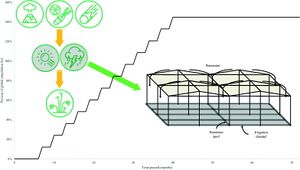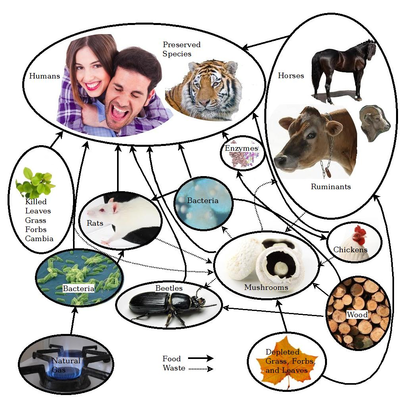
Purpose During a global catastrophe such as a nuclear winter, in which sunlight and temperatures are reduced across every latitude, to maintain global agricultural output it is necessary to grow some crops under structures. This study designs a method for scaling up crop production in low-tech greenhouses to contribute to global food sustainability during global catastrophic conditions. Constructing low-tech greenhouses would obviate growing crops using more expensive and energy intensive artificial light. Methods A nuclear winter climate model is used to determine conditions for which greenhouses would need to compensate. The greenhouse structures are designed to utilize global markets of timber, polymer film, construction aggregates, and steel nails.
Results The limiting market that determines the growth rate of the greenhouses is the rate at which polymer film and sheet are currently extruded. Conditions under low-tech greenhouses in the tropics would feasibly accommodate the production of nearly all crops. Some supplemental lighting would be required for long day crops.
Conclusions The analysis shows that the added cost of low-tech greenhouses is about two orders of magnitude lower than the added cost of artificial light growth. The retail cost of food from these low-tech greenhouses will be ~2.30 USD/kg dry food higher than current costs; for instance, a 160% retail cost increase for rice. According to the proposed scaling method, the greenhouses will provide 36% of food requirements for everyone by the end of the first year, and feed everyone after 30 months.
Highlights[edit | edit source]
- An alternative food production solution in a low sunlight catastrophe is greenhouse agriculture.
- Required current global markets for timber, polymer film, steel nails, and gravel are analyzed.
- The scaling rate considers the possibility of crop transplantation.
- Rapid scaling of greenhouses could be useful in a range of scenarios from nuclear winter to abrupt climate change.
- The economic analysis shows far lower cost for greenhouses than artificial light.
Keywords[edit | edit source]
Greenhouses; Low sunlight; Nuclear winter; Existential risk; alternative food; existential risk; global catastrophic risk; public health; sustainable food systems
See also[edit | edit source]

- Feeding Everyone No Matter What - The full book main page
- David Denkenberger and Joshua Pearce, Feeding Everyone No Matter What: Managing Food Security After Global Catastrophe , 1st Edition, Academic Press, 2015
- Free Preview: Google books
- Cover on Academia
- Facebook page
- Alternative Foods as a Solution to Global Food Supply Catastrophes
- Resilience to global food supply catastrophes
- Feeding Everyone if the Sun is Obscured and Industry is Disabled
- Cost-Effectiveness of Interventions for Alternate Food to Address Agricultural Catastrophes Globally
- Feeding Everyone: Solving the Food Crisis in Event of Global Catastrophes that Kill Crops or Obscure the Sun
- Food without sun: Price and life-saving potential
- Cost-effectiveness of interventions for alternate food in the United States to address agricultural catastrophes
- Micronutrient Availability in Alternative Foods During Agricultural Catastrophes
- Preliminary Automated Determination of Edibility of Alternative Foods: Non-Targeted Screening for Toxins in Red Maple Leaf Concentrate
- Open Source Software Toolchain for Automated Non-Targeted Screening for Toxins in Alternative Foods
- Scaling of greenhouse crop production in low sunlight scenarios
- Potential of microbial protein from hydrogen for preventing mass starvation in catastrophic scenarios
- U.S. Potential of Sustainable Backyard Distributed Animal and Plant Protein Production During & After Pandemics
- Global distribution of forest classes and leaf biomass for use as alternative foods to minimize malnutrition
- Long-term cost-effectiveness of interventions for loss of electricity/industry compared to artificial general intelligence safety
- Long term cost-effectiveness of resilient foods for global catastrophes compared to artificial general intelligence safety
- Rapid repurposing of pulp and paper mills, biorefineries, and breweries for lignocellulosic sugar production in global food catastrophes
- Nutrition in Abrupt Sunlight Reduction Scenarios: Envisioning Feasible Balanced Diets on Resilient Foods
- Methane Single Cell Protein: securing protein supply during global food catastrophes
- Killing two birds with one stone: chemical and biological upcycling of polyethylene terephthalate plastics into food
- How Easy is it to Feed Everyone? Economic Alternatives to Eliminate Human Nutrition Deficits
- Quantifying Alternative Food Potential of Agricultural Residue in Rural Communities of Sub-Saharan Africa
- Yield and Toxin Analysis of Leaf Protein Concentrate from Common North American Coniferous Trees
- Toxic Analysis of Leaf Protein Concentrate Regarding Common Agricultural Residues
- Towards Sustainable Protein Sources: The Thermal and Rheological Properties of Alternative Proteins
Additional Information[edit source]
- ALLFED
- Dave Denkenberger Publications
- OSE Wiki "Synfood" (i.e. protein and other dietary components from microbial organisms fed on gas or other hydrocarbons)






